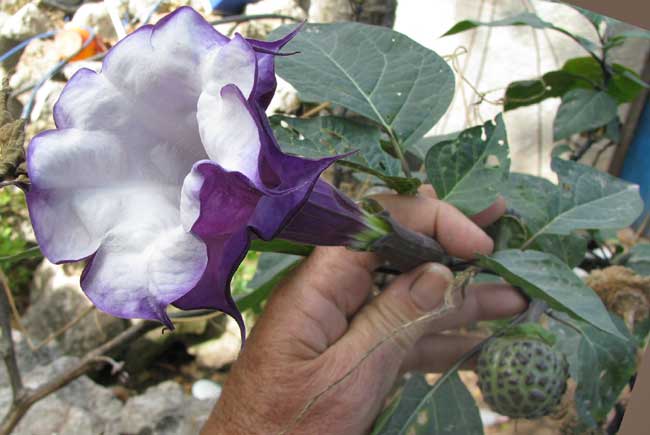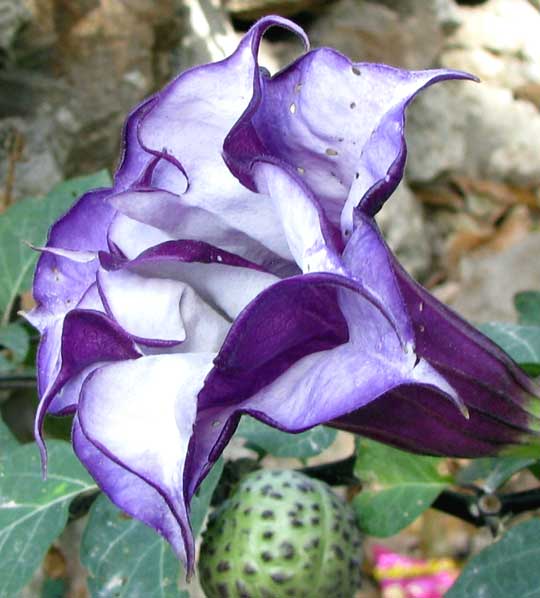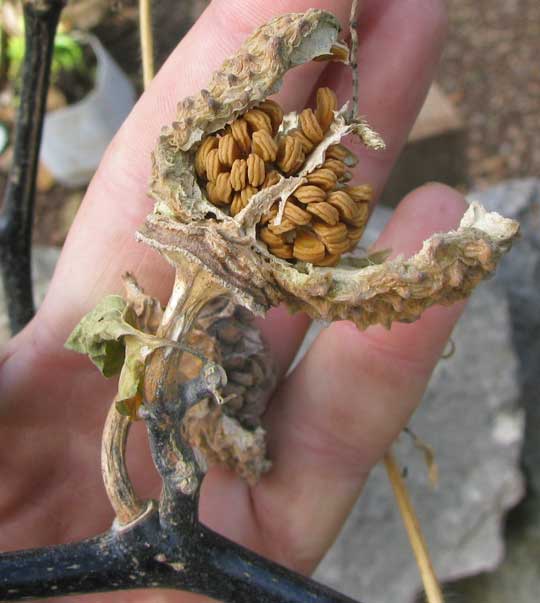Excerpts from Jim Conrad's
Naturalist Newsletter

from the January 2, 2011 Newsletter issued from Hacienda Chichen Resort beside Chichén Itzá Ruins, central Yucatán, MÉXICO; limestone bedrock, elevation ~39m (~128ft), ~N20.676°, ~W88.569°
DOUBLE PURPLE DATURA
Wandering Pisté's backstreets, next to a humble, thatch-roofed hut and bending over a half-collapsed stone wall there was a bushy, five-ft-tall (1.5m) herbaceous plant with the spectacular blossom shown above.
That blossom is about seven inches long (18 cm). It's a double-blossomed cultivar. A close-up showing better how the inner and outer corollas relate is shown below:

Some fruit-capsules on the plant were mature and apparently had been broken open by birds feeding on the large, brown seeds. You can see such a fruit below:

This horticultural creation is derived from the wild Datura metel, which is native to India and southeast Asia. The cultivar is known as 'Fastuosa," so the technical name for the plant is DATURA METEL 'FASTUOSA.' The horticultural form is so widely planted throughout the world's tropics that it's known by numerous English names, such as "Purple Hindu," "Blackcurrant Swirl" and "Cornucopaea." Since it's a member of the genus Datura and bears double, purple-tinged flowers, maybe the most appropriate name is "Double Purple Datura."
At first I thought that this was a form of Angel's Trumpet, Brugmansia arborea, native to the Andes, which we met back in Querétaro, and which still is shown at www.backyardnature.net/q/datura-a.htm.
Among the big differences between Angel's Trumpets and Double Purple Datura is that the Angel's Trumpets' flowers are pendulous on a woody, perennial bush, while the Double Purple Datura's flowers are erect on herbaceous, annual stems.
You may remember the Carlos Castinada books of several decades ago in which the Yaqui Indian called Don Juan concocted hallucinogenic potions using "Devil Weed," which was a Datura -- the same genus as our Double Purple Datura. Don Juan was using a different species, but in fact all parts of our Pisté plant, as well as all other species of Datura, are poisonous. Eating this plant in large enough quantity can be fatal for humans, livestock and pets. Even eating small amounts of it can cause severe headache, hallucinations or unconsciousness.
That being said, the Asian plant from which this cultivar was developed has been cultivated for centuries in China and India for medicinal uses, extracts of its leaves and seeds being used for a very wide range of ailments. However, the medicinal dose is very close to the toxic dose, so amateur healers shouldn't fool with this plant, or any of the Daturas.